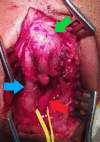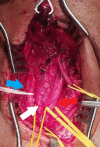Vagal Paraganglioma: A Rare Finding in a 31-Year-Old Male
- PMID: 34733595
- PMCID: PMC8557702
- DOI: 10.7759/cureus.18423
Vagal Paraganglioma: A Rare Finding in a 31-Year-Old Male
Abstract
Vagal paraganglioma is a rare finding that develops from paraganglionic tissue found around the vagus nerve; it has a prevalence of 0.012% of all tumors. It is the third most common paraganglioma of the head and neck but still accounts for less than 5% of these tumors, and it has a well-established female prevalence. It is a difficult tumor to identify early based on its symptoms alone and only a thorough investigation can help solidify its diagnosis. In this report, we discuss a presentation of this phenomenon that is not only unique in its manifestation but also a very difficult diagnosis due to its deceptive presentation and multiple extensions. These masses need a good surgical regime to be removed properly and postoperative complications are very frequent in most of these cases.
Keywords: fever in vagus nerve paraganglioma; general and vascular surgery; glomus vagale; head and neck neoplasms; key words: carotid body tumor; paraganglioma; vagal paraganglioma; vagus nerve.
Copyright © 2021, Ahmed et al.
Conflict of interest statement
The authors have declared that no competing interests exist.
Figures



References
-
- Neurotologic skull base surgery for glomus tumors. Diagnosis for treatment planning and treatment options. Jackson CG. Laryngoscope. 1993;103:17–22. - PubMed
-
- Vagal body tumors. Arts HA, Fagan PA. Otolaryngol Head Neck Surg. 1991;105:78–85. - PubMed
-
- Glomus vagale tumors. Davidson J, Gullane P. Otolaryngol Head Neck Surg. 1988;99:66–70. - PubMed
Publication types
LinkOut - more resources
Full Text Sources
